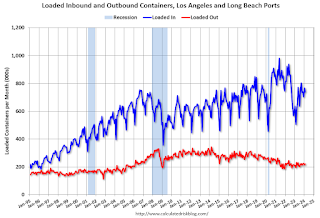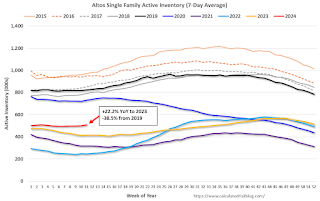by Calculated Risk on 3/19/2024 01:40:00 PM
Tuesday, March 19, 2024
California February Existing Home Sales increase 1.3% YoY, Prices up 9.7% YoY
Today, in the Calculated Risk Real Estate Newsletter: California February Existing Home Sales increase 1.3% YoY, Prices up 9.7% YoY
A brief excerpt:
February’s sales pace jumped 12.8 percent higher from the revised 257,040 homes sold in January and rose 1.3 percent from a year ago, when a revised 286,290 homes were sold on an annualized basis.
...
The statewide median price recorded a strong year-over-year gain in February, gaining 9.7 percent from $735,300 in February 2023 to $806,490 in February 2024.
Single Family Starts Up 35% Year-over-year in February; Multi-Family Starts Down Sharply
by Calculated Risk on 3/19/2024 10:12:00 AM
Today, in the Calculated Risk Real Estate Newsletter: Single Family Starts Up 35% Year-over-year in February; Multi-Family Starts Down Sharply
A brief excerpt:
Total housing starts in February were above expectations and starts in December and January were revised up.
Last month, I noted that permits held up better than starts in January, and that housing starts were impacted by the severe weather in January. For February, permits and starts were at about the same level.
The third graph shows the month-to-month comparison for total starts between 2023 (blue) and 2024 (red).
Total starts were up 5.9% in February compared to February 2023.
Starts were up year-over-year for the third consecutive month, after being down year-over-year for 16 of the previous 18 months.
Housing Starts Increased to 1.521 million Annual Rate in February
by Calculated Risk on 3/19/2024 08:30:00 AM
From the Census Bureau: Permits, Starts and Completions
Housing Starts:
Privately‐owned housing starts in February were at a seasonally adjusted annual rate of 1,521,000. This is 10.7 percent above the revised January estimate of 1,374,000 and is 5.9 percent above the February 2023 rate of 1,436,000. Single‐family housing starts in February were at a rate of 1,129,000; this is 11.6 percent above the revised January figure of 1,012,000. The February rate for units in buildings with five units or more was 377,000.
Building Permits:
Privately‐owned housing units authorized by building permits in February were at a seasonally adjusted annual rate of 1,518,000. This is 1.9 percent above the revised January rate of 1,489,000 and is 2.4 percent above the February 2023 rate of 1,482,000. Single‐family authorizations in February were at a rate of 1,031,000; this is 1.0 percent above the revised January figure of 1,021,000. Authorizations of units in buildings with five units or more were at a rate of 429,000 in February.
emphasis added
 Click on graph for larger image.
Click on graph for larger image.The first graph shows single and multi-family housing starts since 2000.
Multi-family starts (blue, 2+ units) increased in February compared to January. Multi-family starts were down 34.8% year-over-year in February.
Single-family starts (red) increased in February and were up 35.2% year-over-year.
 The second graph shows single and multi-family housing starts since 1968.
The second graph shows single and multi-family housing starts since 1968. This shows the huge collapse following the housing bubble, and then the eventual recovery - and the recent collapse and recovery in single-family starts.
Total housing starts in February were above expectations and starts in December and January were revised up.
I'll have more later …
Monday, March 18, 2024
"The Lock-In Effect of Rising Mortgage Rates"
by Calculated Risk on 3/18/2024 08:19:00 PM
Today, in the Calculated Risk Real Estate Newsletter: "The Lock-In Effect of Rising Mortgage Rates"
A brief excerpt:
Here is new working paper from Federal Housing Finance Agency (FHFA) staff Ross M. Batzer Jonah R. Coste William M. Doerner Michael J. Seiler quantifying the impact of the “lock-in effect”: The Lock-In Effect of Rising Mortgage RatesThere is much more in the article.
And here is their conclusion:This paper finds that for every percentage point that market mortgage rates exceed the origination interest rate, the probability of sale is decreased by 18.1%. This mortgage rate lock-in led to a 57% reduction in home sales with fixed-rate mortgages in 2023Q4 and prevented 1.33 million sales between 2022Q2 and 2023Q4. The supply reduction increased home prices by 5.7%, outweighing the direct impact of elevated rates, which decreased prices by 3.3%. These findings underscore how mortgage rate lock-in restricts mobility, results in people not living in homes they would prefer, inflates prices, and worsens affordability.
emphasis added
Tuesday: Housing Starts
by Calculated Risk on 3/18/2024 07:24:00 PM

Rates marched higher to the highest levels in March today, but most lenders are only microscopically worse off than Friday afternoon. In the slightly bigger picture rates have moved up roughly a quarter of a percent in just over a week and that's a relatively quick move.Tuesday:
...
We already know the Fed will not be cutting rates. We don't know how they'll adjust their rate outlook for the rest of the year. [30 year fixed 7.11%]
emphasis added
• At 8:30 AM ET, Housing Starts for February. The consensus is for 1.435 million SAAR, up from 1.331 million SAAR.
MBA Survey: Share of Mortgage Loans in Forbearance Holds Steady at 0.22% in February
by Calculated Risk on 3/18/2024 04:23:00 PM
From the MBA: Share of Mortgage Loans in Forbearance Holds Steady at 0.22% in February
The Mortgage Bankers Association’s (MBA) monthly Loan Monitoring Survey revealed that the total number of loans now in forbearance remained unchanged at 0.22% as of February 29, 2024. According to MBA’s estimate, 110,000 homeowners are in forbearance plans. Mortgage servicers have provided forbearance to approximately 8.1 million borrowers since March 2020.At the end of February, there were about 110,000 homeowners in forbearance plans.
In February 2024, the share of Fannie Mae and Freddie Mac loans in forbearance declined 1 basis point to 0.12%. Ginnie Mae loans in forbearance increased by 1 basis point to 0.40%, and the forbearance share for portfolio loans and private-label securities (PLS) increased 1 basis point to 0.29%.
“The performance of servicing portfolios and loan workouts improved in February, as borrowers benefitted from tax refunds, the extra day in the month to submit their payments, and continued resilience in the job market,” said Marina Walsh, CMB, MBA’s Vice President of Industry Analysis. “Only around 110,000 loans nationwide remain in a forbearance plan, with little movement this month. The pandemic’s impact has waned, with only 16 percent of borrowers in forbearance because of COVID-19, compared to 72 percent for temporary personal hardships and 12 percent for natural disasters.”
emphasis added
LA Port Traffic Increased Sharply Year-over-year in February
by Calculated Risk on 3/18/2024 01:51:00 PM
Container traffic gives us an idea about the volume of goods being exported and imported - and usually some hints about the trade report since LA area ports handle about 40% of the nation's container port traffic.
The following graphs are for inbound and outbound traffic at the ports of Los Angeles and Long Beach in TEUs (TEUs: 20-foot equivalent units or 20-foot-long cargo container).
To remove the strong seasonal component for inbound traffic, the first graph shows the rolling 12-month average.

On a rolling 12-month basis, inbound traffic increased 2.8% in February compared to the rolling 12 months ending in January. Outbound traffic increased 1.0% compared to the rolling 12 months ending the previous month.
 Usually imports peak in the July to October period as retailers import goods for the Christmas holiday, and then decline sharply and bottom in the Winter depending on the timing of the Chinese New Year.
Usually imports peak in the July to October period as retailers import goods for the Christmas holiday, and then decline sharply and bottom in the Winter depending on the timing of the Chinese New Year. NAHB: Builder Confidence Increased in March
by Calculated Risk on 3/18/2024 10:00:00 AM
The National Association of Home Builders (NAHB) reported the housing market index (HMI) was at 51, up from 48 last month. Any number above 50 indicates that more builders view sales conditions as good than poor.
From the NAHB: Builder Sentiment Rises Above Breakeven Point
A lack of existing inventory that continues to drive buyers to new home construction, coupled with strong demand and mortgage rates below last fall’s cycle peak helped push builder sentiment above a key marker in March.
Builder confidence in the market for newly built single-family homes climbed three points to 51 in March, according to the National Association of Home Builders (NAHB)/Wells Fargo Housing Market Index (HMI) released today. This is the highest level since July 2023 and marks the fourth consecutive monthly gain for the index. It is also the first time that the sentiment level has surpassed the breakeven point of 50 since last July.
“Buyer demand remains brisk and we expect more consumers to jump off the sidelines and into the marketplace if mortgage rates continue to fall later this year,” said NAHB Chairman Carl Harris, a custom home builder from Wichita, Kan. “But even though there is strong pent-up demand, builders continue to face several supply-side challenges, including a scarcity of buildable lots and skilled labor, and new restrictive codes that continue to increase the cost of building homes.”
“With the Federal Reserve expected to announce future rate cuts in the second half of 2024, lower financing costs will draw many prospective buyers into the market,” said NAHB Chief Economist Robert Dietz. “However, as home building activity picks up, builders will likely grapple with rising material prices, particularly for lumber.”
With mortgage rates below 7% since mid-December per Freddie Mac, more builders are cutting back on reducing home prices to boost sales. In March, 24% of builders reported cutting home prices, down from 36% in December 2023 and the lowest share since July 2023. However, the average price reduction in March held steady at 6% for the ninth straight month. Meanwhile, the use of sales incentives is holding firm. The share of builders offering some form of incentive in March was 60%, and this has remained between 58% and 62% since last September.
...
All three of the major HMI indices posted gains in March. The HMI index charting current sales conditions increased four points to 56, the component measuring sales expectations in the next six months rose two points to 62 and the component gauging traffic of prospective buyers increased two points to 34.
Looking at the three-month moving averages for regional HMI scores, the Northeast increased two points to 59, the Midwest gained five points to 41, the South rose four points to 50 and the West registered a five-point gain to 43.
emphasis added
 Click on graph for larger image.
Click on graph for larger image.This graph shows the NAHB index since Jan 1985.
This was above the consensus forecast.
Housing March 18th Weekly Update: Inventory Up 1.3% Week-over-week, Up 22.2% Year-over-year
by Calculated Risk on 3/18/2024 08:17:00 AM
 Click on graph for larger image.
Click on graph for larger image.This inventory graph is courtesy of Altos Research.

Sunday, March 17, 2024
Sunday Night Futures
by Calculated Risk on 3/17/2024 09:05:00 PM
Weekend:
• Schedule for Week of March 17, 2024
Monday:
• At 10:00 AM ET, The March NAHB homebuilder survey. The consensus is for a reading of 48, unchanged from 48. Any number below 50 indicates that more builders view sales conditions as poor than good.
From CNBC: Pre-Market Data and Bloomberg futures S&P 500 are up 5 and DOW futures are down 27 (fair value).
Oil prices were up over the last week with WTI futures at $81.14 per barrel and Brent at $85.40 per barrel. A year ago, WTI was at $67, and Brent was at $71 - so WTI oil prices are up 20% year-over-year.
Here is a graph from Gasbuddy.com for nationwide gasoline prices. Nationally prices are at $3.44 per gallon. A year ago, prices were at $3.40 per gallon, so gasoline prices are up $0.04 year-over-year.


